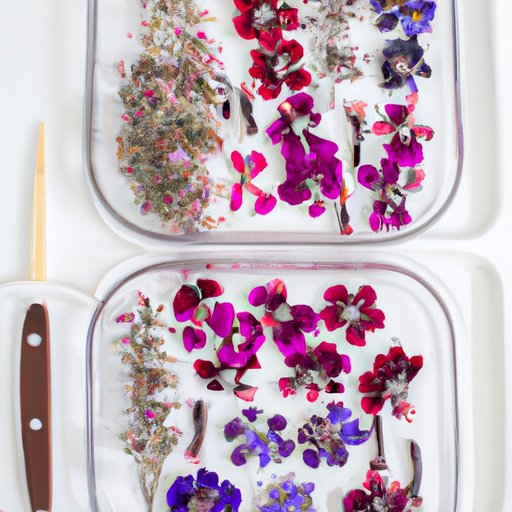
Introduction
Flowers can bring beauty, color, and fragrance to any space, but they don’t have to be fleeting. Drying flowers is an age-old practice that allows you to preserve your blooms for weeks, months, or even years. Dried flowers can add an air of nostalgia to any room and they are perfect for crafting projects. But drying out flowers can be tricky, and if not done properly, it can lead to disappointment. This article will guide you through the process of drying out flowers, from choosing the right technique to avoiding common mistakes.
Step-by-Step Guide
Timing is crucial when it comes to drying out flowers. Flowers should be cut when they are at their peak, before they have begun to wilt or lose their color. Experts recommend cutting flowers in the morning when the dew has dried out, but before the sun is too high. Once you have selected your flowers, you need to determine the best method for drying them.
One of the simplest methods for drying flowers is air-drying. This method involves hanging the flowers upside down in a warm, dry place with good air circulation. You can also use a drying rack or a clothesline for this purpose. Air-drying can take anywhere from a few days to a few weeks, depending on the type of flower and the humidity of the environment. When the flowers are completely dry, you can spray them with a clear acrylic sealer to help preserve them.
If you’re looking for a faster method, you can try using a microwave. To do this, place the flowers between two sheets of absorbent paper and microwave them on low power for one or two minutes at a time until they are dry. Be careful not to overheat the flowers, as this can cause them to scorch or become brittle. Another option is to use silica gel or other drying agents, which can absorb moisture from the flowers more quickly than air-drying or microwaving. Silica gel is a desiccant that can be found at craft or home improvement stores.
If you are working with delicate or small flowers, such as pansies or baby’s breath, you may want to use pressing to dry them out. To do this, arrange the flowers between two pieces of wax paper or newspaper. Place the paper with the flowers between the pages of a heavy book and weigh the book down with a weight or other heavy object. You will need to leave the flowers in the book for several weeks until they are completely dry. Pressed flowers are great for crafting projects or for use in stationary.
Dos and Don’ts
When drying out flowers, there are a few things you should avoid to ensure success. First, avoid drying flowers that are wilted or past their prime. These flowers are more likely to mold and rot than fresh flowers. Additionally, avoid placing flowers in direct sunlight, which can cause the colors to fade. Finally, be careful with drying agents such as silica gel, which can be harmful if ingested.
One of the most common problems when drying out flowers is mold. To avoid this, make sure the flowers are completely dry before storing them. Store dried flowers in a cool, dry place away from direct sunlight. You can also add a few drops of essential oil, such as lavender or peppermint, to the dried flowers to deter pests.
When using tools such as microwaves, ovens, or silica gel, you should take the necessary safety precautions. Wear gloves when handling hot objects and follow the instructions on the packaging carefully. If you are unsure about any aspect of the process, seek the guidance of an expert.
Unique Ways to Use Dried Flowers
Dried flowers can be used in a variety of ways, from wreaths and centerpieces to potpourri and sachets. For a natural and fragrant alternative to store-bought potpourri, mix dried flowers with essential oils and store them in a decorative jar or container. You can also use dried flowers to make unique gifts, such as handmade cards or bookmarks. Dried flowers are also great for decorating wedding invitations, or for adding a personal touch to photo frames or shadow boxes.
Personal Experience or Case Study
When it comes to drying out flowers, experimentation is key. I once attempted to dry out a bouquet of roses using a microwave, and ended up with a hot mess. The roses became scorched and the kitchen smelled like burnt flowers for hours. After this misadventure, I decided to try air-drying, which worked perfectly. The roses dried out beautifully and I was able to use them in a wreath that I still proudly display in my home today.
Conclusion
Drying out flowers can be a fun and rewarding activity that allows you to preserve the beauty of your blooms for months or even years. By selecting the right method for your flowers, avoiding common mistakes, and taking the necessary precautions, you can create stunning pieces of decor or gifts that reflect your style and creativity.





